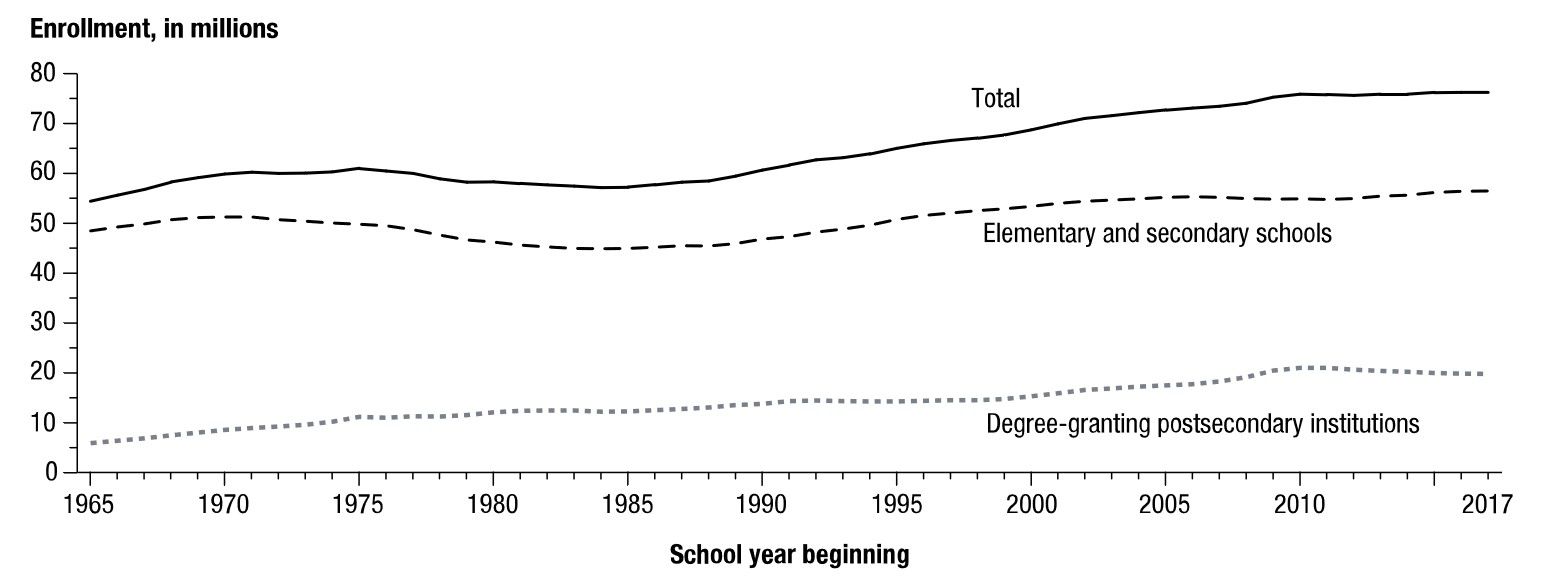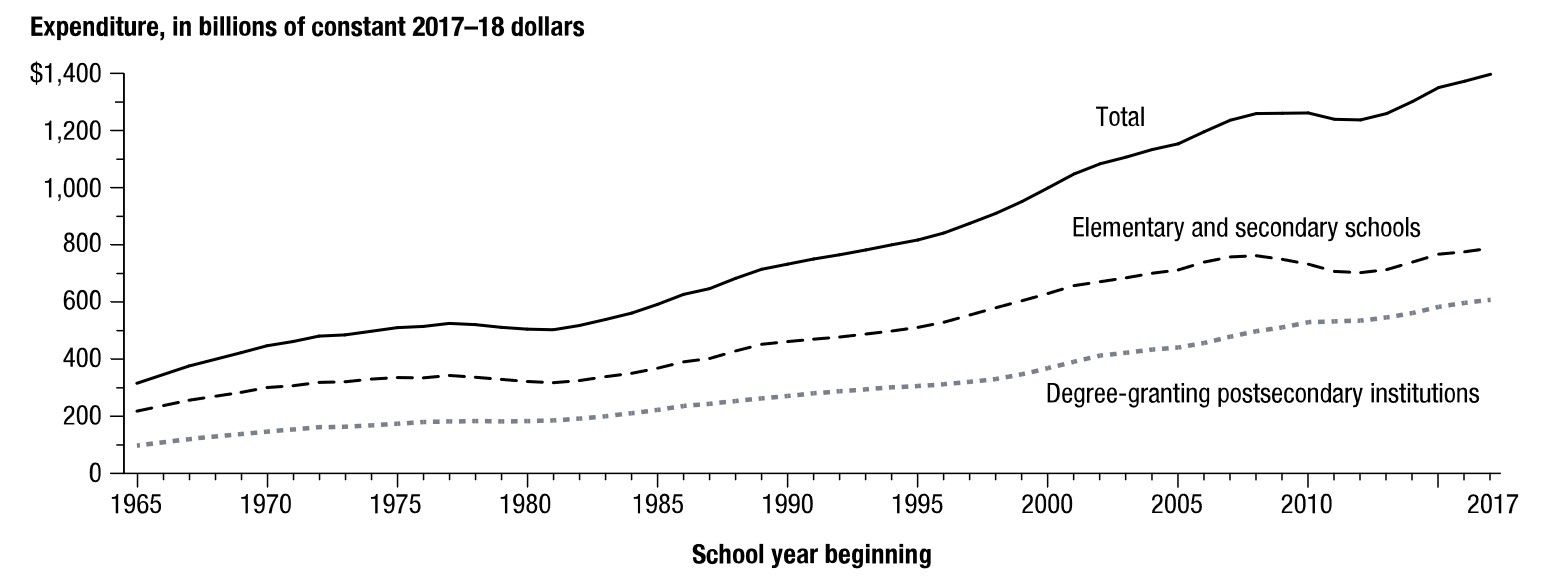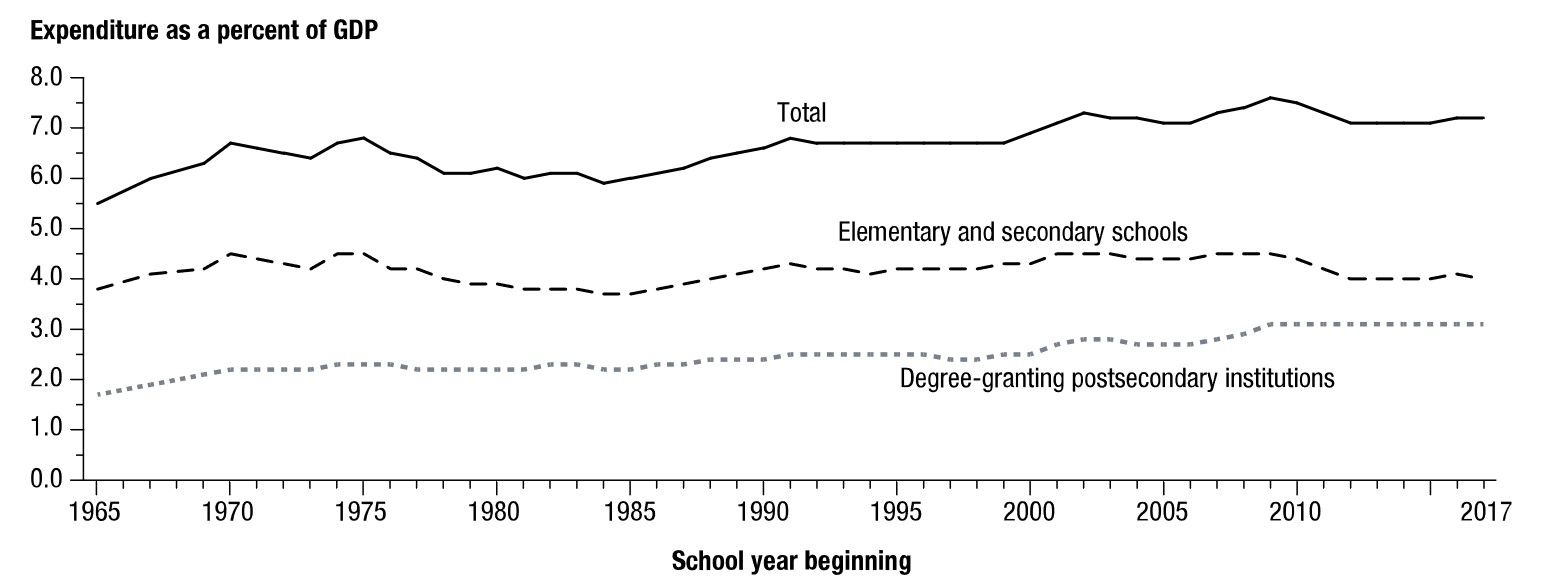Students
According to information from the National Center for Educational Statistics In 2020, 56.4 million students were expected in the entire basic education system, divided into: 1.5 million in pre-kindergarten (K1-2), 3.7 million in kindergarten (K3), 35.3 million in primary and secondary education (Elementary School and Middle School), and 15. 4 in preparatory (High School). [1]. This number has remained with minimal variation for the last 5 years and is expected to continue this way for the next 5 years. [2]. It is expected to grow at a rate of 2% per year until 2028. [1].
Basic education in the United States is dominated by the public sector. Public education covered 50.7 million students, while private education reached 5.7 million. [1].

Schools
For the 2015-2016 cycle (latest complete data available) there were 132,853 schools in the country. Of these, 98,277 were public schools and 34,576 were private schools. Of the public schools, there were 66,758 were elementary education (K1-8), 24,040 were high school (K9-12), and 6,788 combined. [3].
These numbers have remained fairly stable since the 2007-2008 cycle, where there were also 98,916 public schools and 33,740 private ones. [3].
Investment in education
Spending per student in education will reach $ 14,000 this 2020-21 cycle. Which adds up to a total spending on education of $ 709 billion. [These data are estimates for the year, so they do not take into account the impact of the coronavirus on the budgetary needs of the education system].
Spending per student has maintained a constant growth in recent years, going from $ 10,663 in the 2010-11 cycle to $ 11,842 in 2015-2016 and to $ 14,000 today. However, this must be discounted for inflation. Expenditure on education as a percentage of GDP has remained stable in the last 10 years, even with a slight decrease in what this figure represented during the 2008 crisis. [5].

Charter schools
Charter schools are a type of private school within the public school system in the United States in which the school is allowed greater autonomy and flexibility of operations as long as it meets certain other established requirements, which are reviewed in a periodic manner. The first charter schools began in Minnesota in 1991 and since then they have been regulated and established in practically every state in the country except for six of them. [5].
Their number has grown from representing 2% of all public schools in the country in the 2000-01 cycle to 7% in 2017-18. In the same period, the total number of students in charter schools went from representing 1% to representing 6%. [5].
If we look at it in total numbers, the change was from 0.4 million students in 2000 to 3.1 million in 2017, a change of 2.7 million. In that same period, the rest of the public schools had a growth of only 0.6 million students. [5].
The number of charter schools with 300-499 students, 500-999 and more than 1000 students has also grown, while the number of schools with less than 300 has decreased, which speaks to the growth of the size of the schools and a consolidation of the model. [5].
The student body of these schools is mainly made up of the low and medium-low income families and the school is usually associated with community organizations and charities.
Our relationship and opportunity
According to information from the National Center for Educational Statistics In 2020, 56.4 million students were expected in the entire basic education system, divided into: 1.5 million in pre-kindergarten (K1-2), 3.7 million in kindergarten (K3), 35.3 million in primary and secondary education (Elementary School and Middle School), and 15. 4 in preparatory (High School). [1]. This number has remained with minimal variation for the last 5 years and is expected to continue this way for the next 5 years. [2]. It is expected to grow at a rate of 2% per year until 2028. [1].
Basic education in the United States is dominated by the public sector. Public education covered 50.7 million students, while private education reached 5.7 million. [1].

[4]
Schools
For the 2015-2016 cycle (latest complete data available) there were 132,853 schools in the country. Of these, 98,277 were public schools and 34,576 were private schools. Of the public schools, there were 66,758 were elementary education (K1-8), 24,040 were high school (K9-12), and 6,788 combined. [3].
These numbers have remained fairly stable since the 2007-2008 cycle, where there were also 98,916 public schools and 33,740 private ones. [3].
Investment in education
Spending per student in education will reach $ 14,000 this 2020-21 cycle. Which adds up to a total spending on education of $ 709 billion. [These data are estimates for the year, so they do not take into account the impact of the coronavirus on the budgetary needs of the education system].
Spending per student has maintained a constant growth in recent years, going from $ 10,663 in the 2010-11 cycle to $ 11,842 in 2015-2016 and to $ 14,000 today. However, this must be discounted for inflation. Expenditure on education as a percentage of GDP has remained stable in the last 10 years, even with a slight decrease in what this figure represented during the 2008 crisis. [5].

[4]

[4]

[4]
Charter schools
Charter schools are a type of private school within the public school system in the United States in which the school is allowed greater autonomy and flexibility of operations as long as it meets certain other established requirements, which are reviewed in a periodic manner. The first charter schools began in Minnesota in 1991 and since then they have been regulated and established in practically every state in the country except for six of them. [5].
Their number has grown from representing 2% of all public schools in the country in the 2000-01 cycle to 7% in 2017-18. In the same period, the total number of students in charter schools went from representing 1% to representing 6%. [5].
If we look at it in total numbers, the change was from 0.4 million students in 2000 to 3.1 million in 2017, a change of 2.7 million. In that same period, the rest of the public schools had a growth of only 0.6 million students. [5].
The number of charter schools with 300-499 students, 500-999 and more than 1000 students has also grown, while the number of schools with less than 300 has decreased, which speaks to the growth of the size of the schools and a consolidation of the model. [5].
The student body of these schools is mainly made up of the low and medium-low income families and the school is usually associated with community organizations and charities.
Our relationship and opportunity
YEII has had the opportunity to collaborate with charter schools in the state of California implementing an entrepreneurship curriculum. Our program aims to provide useful knowledge and generate development opportunities for young people from all regions and from all contexts.
The work we have done has left a good impression and is currently keeping us busy with conversations for new projects with charter schools and Latino communities in New York City and the Los Angeles area. We seek to detonate the greatest social impact in these communities through educational transformation.
The work we have done has left a good impression and is currently keeping us busy with conversations for new projects with charter schools and Latino communities in New York City and the Los Angeles area. We seek to detonate the greatest social impact in these communities through educational transformation.
Sources
1. https://nces.ed.gov/fastfacts/display.asp?id=372
2. https://nces.ed.gov/programs/digest/d19/tables/dt19_105.30.asp
3. https://nces.ed.gov/fastfacts/display.asp?id=84
4. https://nces.ed.gov/fastfacts/display.asp?id=65
5. https://nces.ed.gov/programs/digest/d19/tables/dt19_236.15.asp